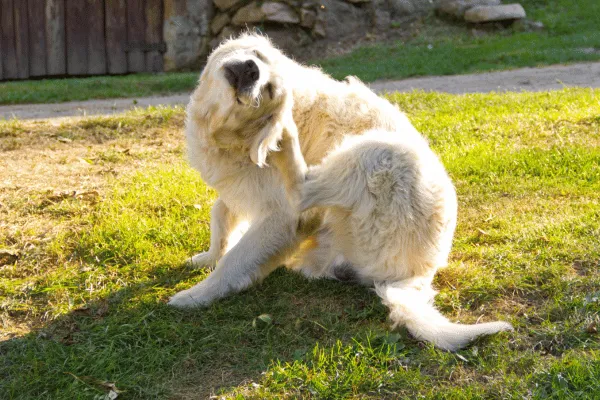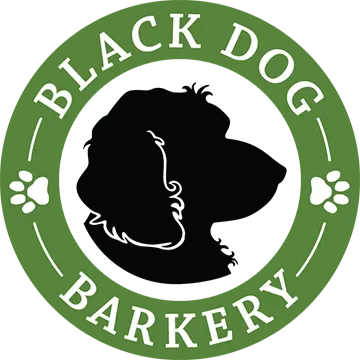Black Dog Blog
Your go-to source for holistic pet care tips.
Black Dog Blog
Welcome to the Black Dog Blog! Your go-to source for holistic pet care.

What Causes Yeast Infections in Dogs?
Yeast infections in dogs are a common concern for many pet parents and are twice as prevalent in the warm summer months. Beyond the discomfort that your dog has, no one likes to hear Fido scratching at all hours of the night!
So, let's dive into the world of yeast and explore the various factors that can lead to a dog becoming itchy and irritated.
What Causes Yeast Infections in Dogs?
Yeast & Dog Health: Yeast Isn't Always the Enemy!
Do Genetic Factors Contribute to Yeast Infections?
Inherited Conditions & Genetic Predisposition
Environmental Influences on Yeast Growth
The Role of Diet in Yeast Infections
Food Allergies and Sensitivities
Medications that Can Lead to Yeast Infections
Corticosteroids and Their Effects
Other Medications Impacting Yeast Growth
Recognizing Symptoms of Yeast Infections
Yeast & Dog Health: Yeast Isn't Always the Enemy!

What is Yeast?
Yeast is a type of fungus that naturally lives on the skin and in the ear canal of dogs. In normal amounts, yeast doesn't cause any harm; it's just a part of the dog’s natural flora.
However, when conditions change, yeast can experience overgrowth and cause problems. Many dogs with allergies are prone to yeast infections because of their compromised immune systems and skin barriers.
Normal Yeast Levels in Dogs
A healthy dog has a balanced ecosystem on their skin, where yeast exists in harmony with other microorganisms. The immune system keeps the yeast population in check, preventing overgrowth.
When the immune system is functioning correctly, the dog's skin remains healthy. Understanding this balance is key to help prevent yeast infections. Factors like diet and environment play a huge role in maintaining these normal levels.
When Yeast Becomes a Problem
Yeast infections in dogs occurs when there is an overgrowth of yeast, leading to yeast dermatitis or an infection of the skin. This overgrowth can be triggered by various factors, including allergies, humidity, and certain medications.
The affected area, such as the dog’s skin folds, paws, or ear canal, becomes itchy and inflamed. Many dog breeds, especially those with floppy ears or deep skin folds, are more susceptible to developing yeast infections.
If your dog has a yeast infection, it's important to consult with a vet to determine the underlying cause and make necessary changes to prevent yeast infections from reccurring.
Do Genetic Factors Contribute to Yeast Infections?

Breed Susceptibility
Certain dog breeds are more prone to yeast infections due to their unique physical characteristics. Breeds with floppy ears, such as Cocker Spaniels and Basset Hounds, are more likely to develop ear infections because their ear canals tend to trap moisture, creating an ideal environment for yeast overgrowth.
Dog breeds with deep skin folds, like Bulldogs and Shar-Peis, can also experience yeast dermatitis due to the lack of airflow and increased moisture in those areas. If you know that your dog could be predisposed to yeast overgrowth, it's easy to take proactive measures to avoid yeast from becoming a problem for your furbaby.
Inherited Conditions & Genetic Predisposition
Yeast doesn't just go along with different breed or dog characteristics, inherited conditions and genetic predisposition can also play a significant role in a dog's susceptibility to yeast infections as well.
Some dogs may inherit immune system deficiencies or just simply be genetically more likely to be unable to control the natural yeast on their skin, leading to frequent yeast overgrowth.
Regular visits to the vet can help identify and manage these underlying conditions, helping to prevent yeast infections and keep your dog healthy. Certain dog foods can help with this as well.
Environmental Influences on Yeast Growth

Humidity and Temperature
Humidity and temperature play a huge role in whether your dog develops a yeast infection. Yeast thrives in warm, moist environments. Here in Bristol, TN and surrounding areas where the humidity is routinely high in the summer, conditions are perfect for year infections to sprout up.
Aside from just our normal humidity, for dogs who spend a lot of time in the water during the summer, their damp fur can create the perfect conditions for yeast overgrowth on their skin.
Regular grooming and ensuring your dog is thoroughly dry after baths or swimming can help prevent yeast infections by reducing the moisture available for yeast to flourish.
Living Conditions
The conditions in which your dog lives can also significantly impact the likelihood of yeast overgrowth. Poor ventilation, damp bedding, or unclean living spaces can all contribute to an environment that favors yeast.
Regularly cleaning and disinfecting your dog's bedding and living areas can help prevent yeast infections. Also, consider using breathable materials for bedding to reduce moisture build-up. Ensuring a clean and dry environment will promote your dog's skin health.
We recommend having different dog beds or bedding depending on the season. Summer bedding is more lightweight and breathable to not trap excess moisture or heat while winter bedding is more plush and warm.
Exposure to Allergens
Exposure to allergens can weaken your dog's immune system and disrupt the natural balance of microorganisms on their skin, making them more prone to yeast infections.
Common allergens like pollen, dust mites, and mold spores can cause allergic reactions, leading to inflammation and itchiness. This results in them scratching and damaging their skin, which in turn creates opportunities for yeast to overgrow.
This is another great reason to regularly cleaning your home and your dog's bedding to ensure that they are allergen free. If your dog routinely struggles with yeast, you could also considered placing an air purifier near where they spend most of their time.
The Role of Diet in Yeast Infections

Dietary Imbalances
If you've been around for a little while, you'll know that at Black Dog Barkery, we believe that canine nutrition plays a huge role in the overall wellbeing of our four-legged loved ones. Thus you'll find it now surprise that we see dietary imbalances contributing significantly to yeast infections in dogs.
A diet lacking essential nutrients can compromise the immune system, making it harder for the body to control yeast levels. Nutrient deficiencies can disrupt the skin's natural barrier function, creating an environment where yeast can thrive.
It's crucial to ensure that your dog receives a balanced diet as this help boost their immune system overall and supports their gut microbiome both of which serve to prevent yeast overgrowth and improve overall health.
High-Carbohydrate Diets
Diets high in carbohydrates can also promote yeast overgrowth. Yeast feeds on sugars, so a diet rich in carbohydrates can provide an abundant food source, leading to yeast overgrowth.
Processed dog foods often contain high levels of carbohydrates, so it's important to carefully read the ingredient list. Choosing dog foods with moderate carbohydrate levels and focusing on high-quality protein and healthy fats can help manage yeast levels.
If your dog has a yeast infection, the dog’s skin may be reflecting an imbalance in their diet.
If you're not sure where to start with making dietary changes, we guide our customers through this process regularly! We have many different protein and food options to try as you're working to improve your dog's diet.
Food Allergies and Sensitivities
Food allergies and sensitivities can be a common cause of yeast infections in dogs. When a dog has a food allergy, its immune system reacts to certain ingredients in its diet, leading to inflammation and skin problems. This inflammation can disrupt the skin's natural barrier function, making the dog more susceptible to yeast overgrowth.
Common food allergens for dogs include:
Beef
Chicken
Dairy
Wheat
Sometimes it's necessary to try an elimination diet to determine if your dog has any food allergies or sensitivities contributing to the development of yeast infections
This is helpful because it allows them to trial different protein options or rotate dog food proteins to help them maintain a healthy gut microbiome and cut down on irritation.
Medications that Can Lead to Yeast Infections

Antibiotic Use
Antibiotics can disrupt the natural balance of microorganisms, leading to yeast overgrowth. These medications can disrupt the natural balance of microorganisms in your dog's body, killing both harmful and beneficial bacteria.
This imbalance can create an opportunity for yeast to overgrow, leading to yeast dermatitis, especially in areas like the ear canal or skin folds. If your dog has a yeast infection after antibiotic use, consult with your veterinarian to explore antifungal treatment options to prevent yeast overgrowth.
Corticosteroids and Their Effects
Corticosteroids can increase the risk of yeast infection by suppressing the immune system, especially when used long term. These medications, often prescribed to manage inflammation and allergies, can also increase the risk of yeast infection in dogs.
Yeast is an opportunistic fungus, meaning that if your dogs immune system is suppressed, it will take advantage of that temporary lull in fungus-fighting immune cells and grow as much as possible, resulting in itchy, irritated skin and potential yeast dermatitis.
If your dog is on corticosteroids, monitor it closely for symptoms of yeast infection and consult with your vet about preventative measures.
Other Medications Impacting Yeast Growth
Besides antibiotics and corticosteroids, other medications can also influence yeast growth in dogs. Certain drugs can alter the skin's environment or weaken the immune system, making dogs more prone to yeast infections.
Chemotherapy drugs, for example, can significantly suppress the immune system, creating an opportunity for yeast overgrowth. If your dog is on any long-term medication, discuss potential side effects and preventative strategies with your veterinarian.
It's better to know about these potential issues in advance so you can be diligent about prevention or address these issues as soon as they arise.
Recognizing Symptoms of Yeast Infections

Common Signs of Yeast Infection
Recognizing the signs of a yeast infection in dogs is key so you can address it quickly.
Common symptoms include:
Itchy skin
Excessive scratching, licking, or chewing
Irritation of the paws, ears, or skin folds
Musty or corn-chip odor of your dogs paws, skin, or ears
Hair loss, greasy skin, and scaly patches are also common signs of yeast overgrowth.
When to Consult a Veterinarian
Early diagnosis and treatment are essential. Knowing when to consult a veterinarian about a potential yeast infection is crucial for your dog’s health. If you observe persistent scratching, skin irritation, or any of the other symptoms mentioned, it’s time to seek professional help.
Early diagnosis and antifungal treatment can prevent the infection from spreading and causing further discomfort. Additionally, your vet can identify any underlying causes, such as allergies or immune deficiencies, to help prevent yeast infections from recurring and to keep your dog happy and healthy.
Once you know more about why your dog is getting these infections, you can work to support them to avoid them in the future.
This type of support could look like:
Dietary changes
Dietary supplements
Environmental changes
We're diving into how to prevent yeast infections next week so be sure to check back for the full details!

Copyright Black Dog Barkery 2025 | Terms | Privacy Policy
Website built by Passive Profits Group
Copyright Black Dog Barkery 2025 | Terms | Privacy Policy


